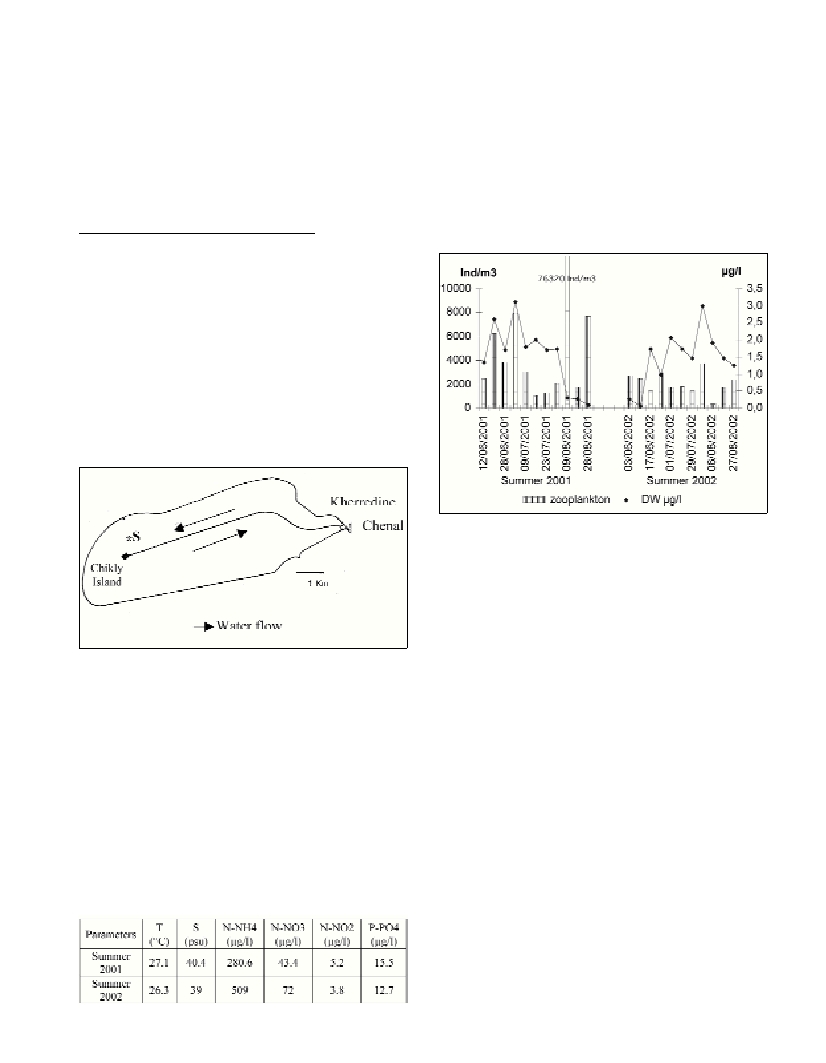DYNAMICS AND BIOMASS OF ZOOPLANKTON IN THE NORTH LAGOON OF TUNIS
(SOUTH WESTERN MEDITERRANEAN LAGOON)
Neila Annabi-Trabelsi
1*
, Mohamed Néjib Daly Yahia
2
, Naceur Ben Maiz
3
et Mohamed Salah Romdhane
4
1
Département de Biologie, Faculté des Sciences de Sfax Tunisie, - * annabi.neila@voila.fr
2
Groupe de recherche d’Hydrologie et de Planctonologie. Faculté des sciences de Bizerte, Tunisie - Nejib.Daly@fsb.rnu.tn
3
Société de Promotion du Lac de Tunis. El Bouhaira, Tunis, Tunisie
4
Institut National Agronomique de Tunisie, Agrocampus, Tunis, Tunisie - romdhane.medsalah@inat.agrinet.tn
Abstract
The aim of this study is to show the sensibility of zooplankton community to abiotic conditions and its inter-annual variations in coastal
marine ecosystems such as the north lagoon of Tunis.
Key words: Zooplankton, copepods, dry weight
Rapp. Comm. int. Mer Médit., 37,2004
474
Introduction
The north lagoon of Tunis (2600 ha) is a shallow (average depth
1.5m) restored lagoon located in the south western Mediterranean
Sea. It communicates with the bay of Tunis by Kherreddine canal and
its hydrodynamic conditions are in?uenced by atmospheric and tidal
rhythms. This study is a part of a monitoring program concerning
physico-chemical parameters and plankton communities, especially
copepod diversity and dynamics, showing the importance of inter-
annual variability. The abundance and biomass of zooplankton and
environmental factors are compared between summer 2001 and 2002.
Materiel and methods
A weekly sampling strategy was undertaken during summer 2001
and 2002 in the monitoring routine station (Fig.1). All zooplankton
and physico-chemicals analyses were done by standard methods
described in literature.
Results and discussion
Surface water salinity, temperature, nitrites and phosphates values
reveal a slight decrease between the two periods of study. However, an
important increase in ammonia and nitrates concentrations was
noticed (Table 1).
The zooplankton was dominated by copepods, appendicularians
and medusae. The comparison between the two periods indicated a
drastic decrease of total zooplankton from 10335 ind/m
3
to 2076
ind/m
3
partially explained by the phytoplankton biomass depletion
(from 0.7µg/l to 0.4 µg/l chlorophyll a) and the abundance of
macrozooplankton competitors (Schyphomedusae) in the second
study period. However, in term of biomass, estimated as dry weight
(1), a very little decrease was observed. In fact, the average values
reached respectively 1512µg/m
3
and 1454 mg/m
3
in summer 2001
and 2002 (Fig.2).
During these two seasons total zooplankton was dominated by
copepod nauplii (91.52 % in summer 2001; 47, 90 in summer 2002)
confirming the nursery role of the lagoon (2). Copepodites and adult
copepods represented respectively 3% and 15.36% in summers 2001
and 2002.
The composition of dominant copepod species was also different in
the two years. During summer 2001, the copepod community was
dominated in order of rank by Labidocera brunescens(28.6%),
Centropages kroyeri(12%), Acartiaclausi(12%) and Euterpina
acutifrons(10%). Whereas, in summer 2002, the dominant copepods
were Centropages kroyeri(20%)Oithona nana(19%), Acartia
discaudata(16%), Acartia clausi(10%) and Euterpina acutifrons
(10%).
This study reveals that the north lagoon of Tunis can be considered
as a mesocosm where herbivorous planktonic populations are in
competition for the limited phytoplankton stock. We hypothesize that
the microbial loop must play an important role in this ecosystem.
Références
1-Omori, M., Ikeda, T., 1984. Methods in marine zooplankton ecology.
New-York, 325 p.
2-Annabi-Trabelsi N., Ayadi H., Ben Maïz N.etTrabelsiE. B., 2001.
Paramètres physico-chimiques, phytoplancton et copépodes d’un milieu
lagunaire restauré: le Lac Nord de Tunis. Rapp. Comm. int. Mer Médit.,
36.
Fig. 1. The sampling station (s) in the north lagoon of Tunis.
Fig. 2. Summer zooplankton and dry weight. Variations in the north
lagoon of Tunis.
Table 1. Average summer values of physico-chemicals. Parameters in
the north lagoon of Tunis.

